Exploring Differences in Sexual Assault Perpetrators: Alcohol's Role
VerifiedAdded on 2023/06/04
|10
|2483
|132
Literature Review
AI Summary
This paper reviews existing literature on sexual assault, specifically focusing on the differences between perpetrators who involve alcohol and those who do not. The study explores factors such as antisocial behavior, impulsivity, empathy, and beliefs about women, comparing men who have committed sexual assault with and without alcohol involvement to non-perpetrators. The research involved a survey of college men, examining their perceptions of sexual assault, personality traits, and behaviors. Results indicated that alcohol-involved perpetrators showed a greater tendency towards alcohol consumption in sexual situations and held stronger beliefs about alcohol enhancing sexual prowess. The study also found a correlation between antisocial behavior and sexual offenses, with individuals holding aggressive attitudes towards women being more likely to commit sexual assault. The review concludes by discussing limitations, suggesting future research directions, and proposing preventive measures to address misconceptions about women's intentions and the role of alcohol in sexual offenses. Desklib provides access to similar documents and study resources for students.
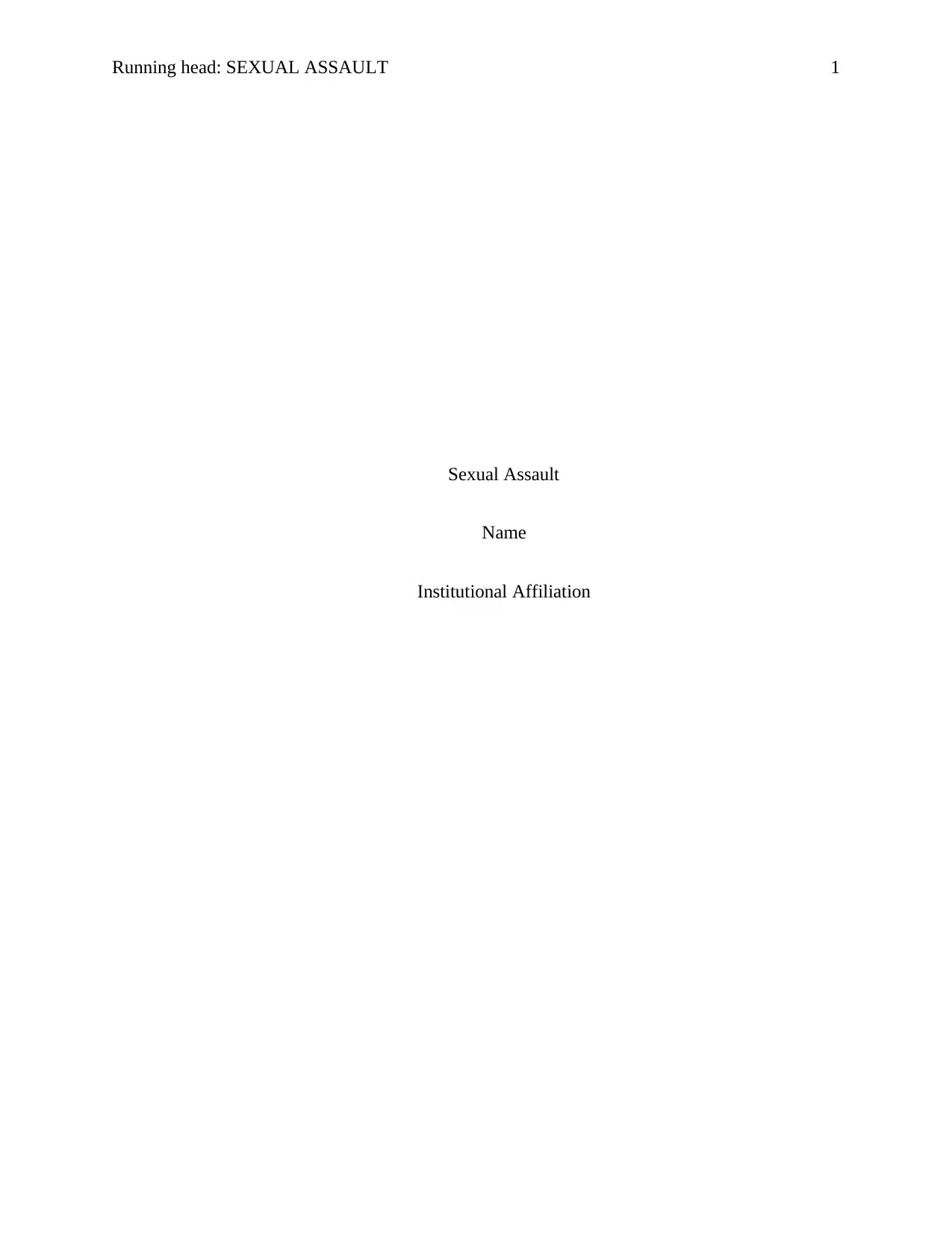
Running head: SEXUAL ASSAULT 1
Sexual Assault
Name
Institutional Affiliation
Sexual Assault
Name
Institutional Affiliation
Secure Best Marks with AI Grader
Need help grading? Try our AI Grader for instant feedback on your assignments.
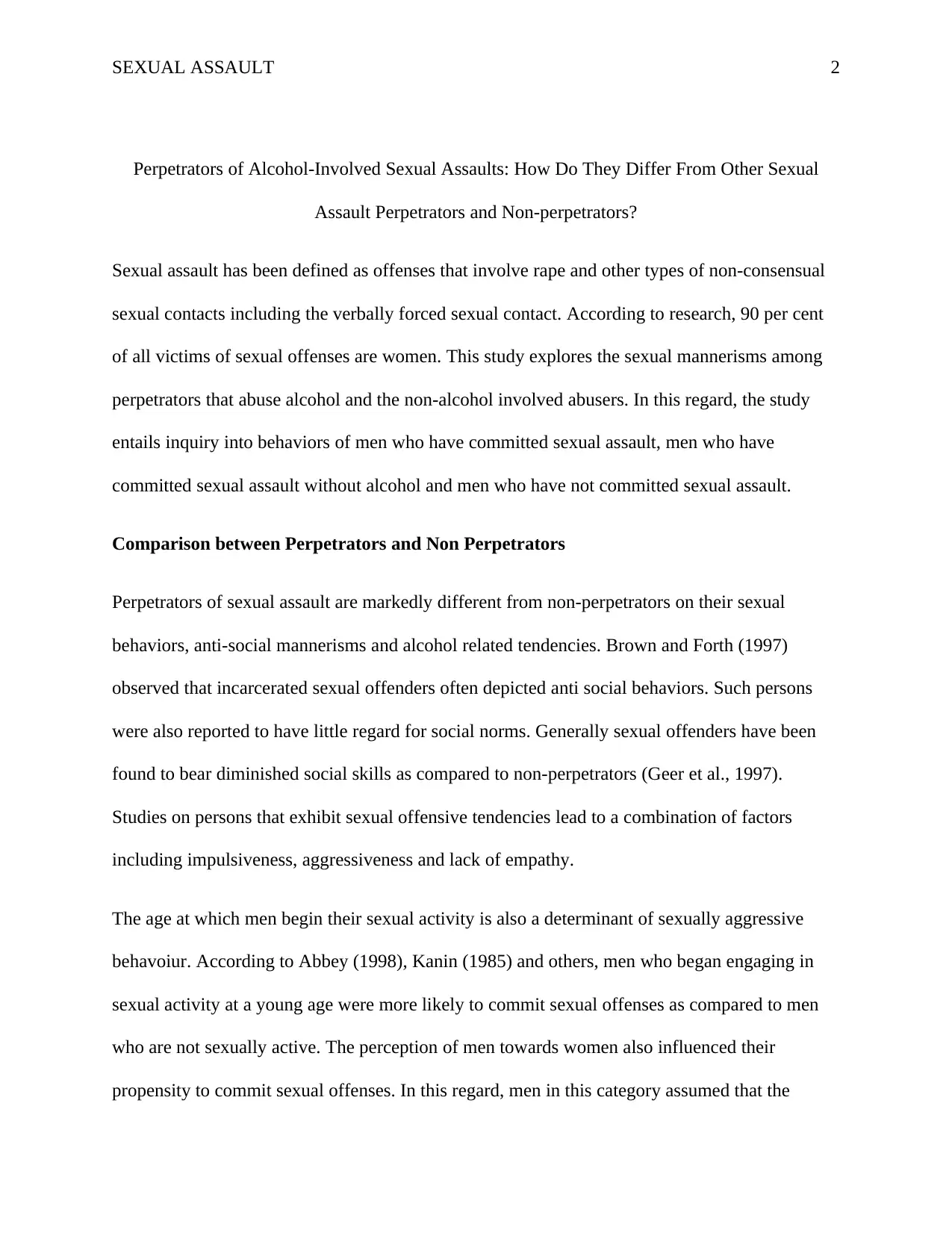
SEXUAL ASSAULT 2
Perpetrators of Alcohol-Involved Sexual Assaults: How Do They Differ From Other Sexual
Assault Perpetrators and Non-perpetrators?
Sexual assault has been defined as offenses that involve rape and other types of non-consensual
sexual contacts including the verbally forced sexual contact. According to research, 90 per cent
of all victims of sexual offenses are women. This study explores the sexual mannerisms among
perpetrators that abuse alcohol and the non-alcohol involved abusers. In this regard, the study
entails inquiry into behaviors of men who have committed sexual assault, men who have
committed sexual assault without alcohol and men who have not committed sexual assault.
Comparison between Perpetrators and Non Perpetrators
Perpetrators of sexual assault are markedly different from non-perpetrators on their sexual
behaviors, anti-social mannerisms and alcohol related tendencies. Brown and Forth (1997)
observed that incarcerated sexual offenders often depicted anti social behaviors. Such persons
were also reported to have little regard for social norms. Generally sexual offenders have been
found to bear diminished social skills as compared to non-perpetrators (Geer et al., 1997).
Studies on persons that exhibit sexual offensive tendencies lead to a combination of factors
including impulsiveness, aggressiveness and lack of empathy.
The age at which men begin their sexual activity is also a determinant of sexually aggressive
behavoiur. According to Abbey (1998), Kanin (1985) and others, men who began engaging in
sexual activity at a young age were more likely to commit sexual offenses as compared to men
who are not sexually active. The perception of men towards women also influenced their
propensity to commit sexual offenses. In this regard, men in this category assumed that the
Perpetrators of Alcohol-Involved Sexual Assaults: How Do They Differ From Other Sexual
Assault Perpetrators and Non-perpetrators?
Sexual assault has been defined as offenses that involve rape and other types of non-consensual
sexual contacts including the verbally forced sexual contact. According to research, 90 per cent
of all victims of sexual offenses are women. This study explores the sexual mannerisms among
perpetrators that abuse alcohol and the non-alcohol involved abusers. In this regard, the study
entails inquiry into behaviors of men who have committed sexual assault, men who have
committed sexual assault without alcohol and men who have not committed sexual assault.
Comparison between Perpetrators and Non Perpetrators
Perpetrators of sexual assault are markedly different from non-perpetrators on their sexual
behaviors, anti-social mannerisms and alcohol related tendencies. Brown and Forth (1997)
observed that incarcerated sexual offenders often depicted anti social behaviors. Such persons
were also reported to have little regard for social norms. Generally sexual offenders have been
found to bear diminished social skills as compared to non-perpetrators (Geer et al., 1997).
Studies on persons that exhibit sexual offensive tendencies lead to a combination of factors
including impulsiveness, aggressiveness and lack of empathy.
The age at which men begin their sexual activity is also a determinant of sexually aggressive
behavoiur. According to Abbey (1998), Kanin (1985) and others, men who began engaging in
sexual activity at a young age were more likely to commit sexual offenses as compared to men
who are not sexually active. The perception of men towards women also influenced their
propensity to commit sexual offenses. In this regard, men in this category assumed that the
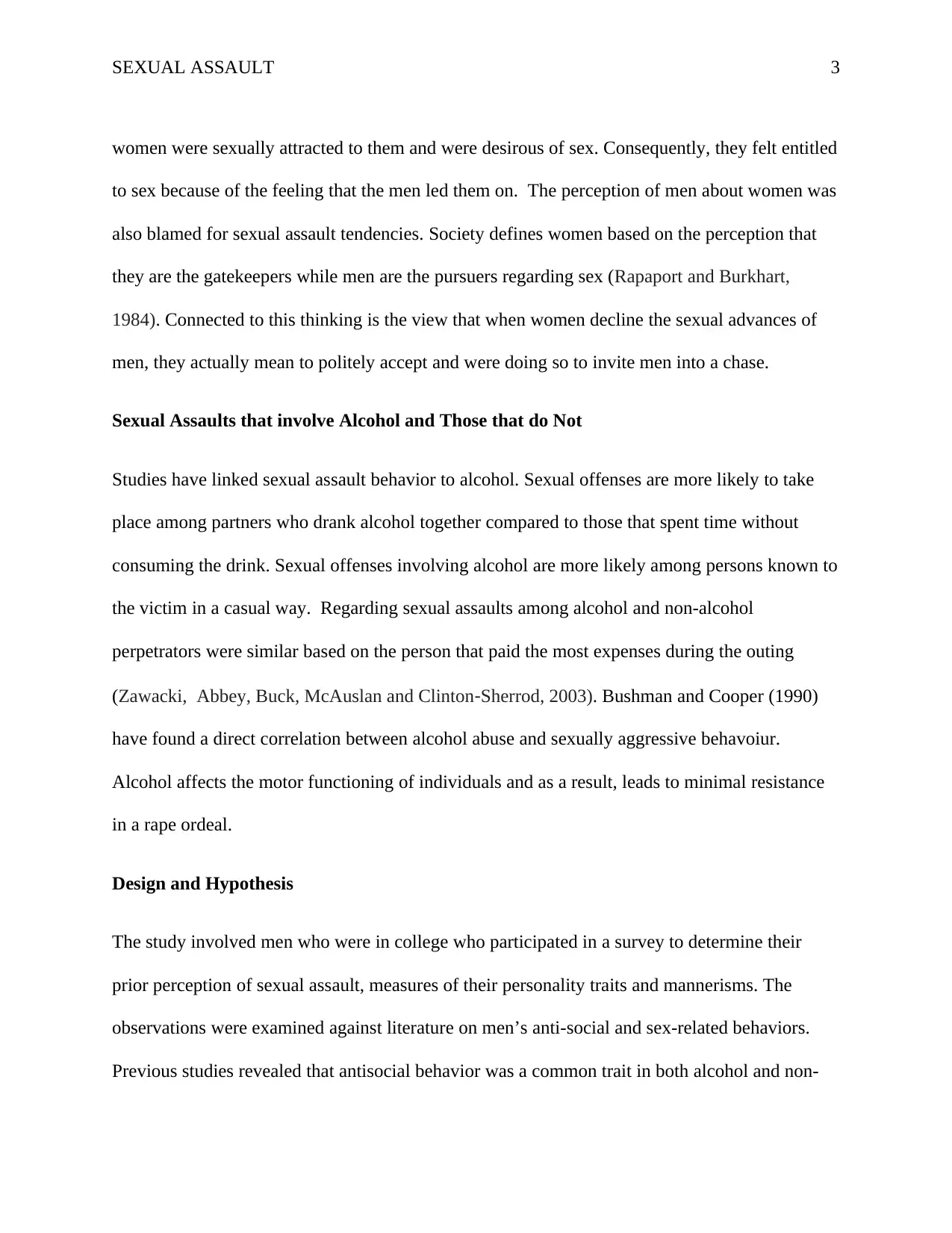
SEXUAL ASSAULT 3
women were sexually attracted to them and were desirous of sex. Consequently, they felt entitled
to sex because of the feeling that the men led them on. The perception of men about women was
also blamed for sexual assault tendencies. Society defines women based on the perception that
they are the gatekeepers while men are the pursuers regarding sex (Rapaport and Burkhart,
1984). Connected to this thinking is the view that when women decline the sexual advances of
men, they actually mean to politely accept and were doing so to invite men into a chase.
Sexual Assaults that involve Alcohol and Those that do Not
Studies have linked sexual assault behavior to alcohol. Sexual offenses are more likely to take
place among partners who drank alcohol together compared to those that spent time without
consuming the drink. Sexual offenses involving alcohol are more likely among persons known to
the victim in a casual way. Regarding sexual assaults among alcohol and non-alcohol
perpetrators were similar based on the person that paid the most expenses during the outing
(Zawacki, Abbey, Buck, McAuslan and Clinton‐Sherrod, 2003). Bushman and Cooper (1990)
have found a direct correlation between alcohol abuse and sexually aggressive behavoiur.
Alcohol affects the motor functioning of individuals and as a result, leads to minimal resistance
in a rape ordeal.
Design and Hypothesis
The study involved men who were in college who participated in a survey to determine their
prior perception of sexual assault, measures of their personality traits and mannerisms. The
observations were examined against literature on men’s anti-social and sex-related behaviors.
Previous studies revealed that antisocial behavior was a common trait in both alcohol and non-
women were sexually attracted to them and were desirous of sex. Consequently, they felt entitled
to sex because of the feeling that the men led them on. The perception of men about women was
also blamed for sexual assault tendencies. Society defines women based on the perception that
they are the gatekeepers while men are the pursuers regarding sex (Rapaport and Burkhart,
1984). Connected to this thinking is the view that when women decline the sexual advances of
men, they actually mean to politely accept and were doing so to invite men into a chase.
Sexual Assaults that involve Alcohol and Those that do Not
Studies have linked sexual assault behavior to alcohol. Sexual offenses are more likely to take
place among partners who drank alcohol together compared to those that spent time without
consuming the drink. Sexual offenses involving alcohol are more likely among persons known to
the victim in a casual way. Regarding sexual assaults among alcohol and non-alcohol
perpetrators were similar based on the person that paid the most expenses during the outing
(Zawacki, Abbey, Buck, McAuslan and Clinton‐Sherrod, 2003). Bushman and Cooper (1990)
have found a direct correlation between alcohol abuse and sexually aggressive behavoiur.
Alcohol affects the motor functioning of individuals and as a result, leads to minimal resistance
in a rape ordeal.
Design and Hypothesis
The study involved men who were in college who participated in a survey to determine their
prior perception of sexual assault, measures of their personality traits and mannerisms. The
observations were examined against literature on men’s anti-social and sex-related behaviors.
Previous studies revealed that antisocial behavior was a common trait in both alcohol and non-
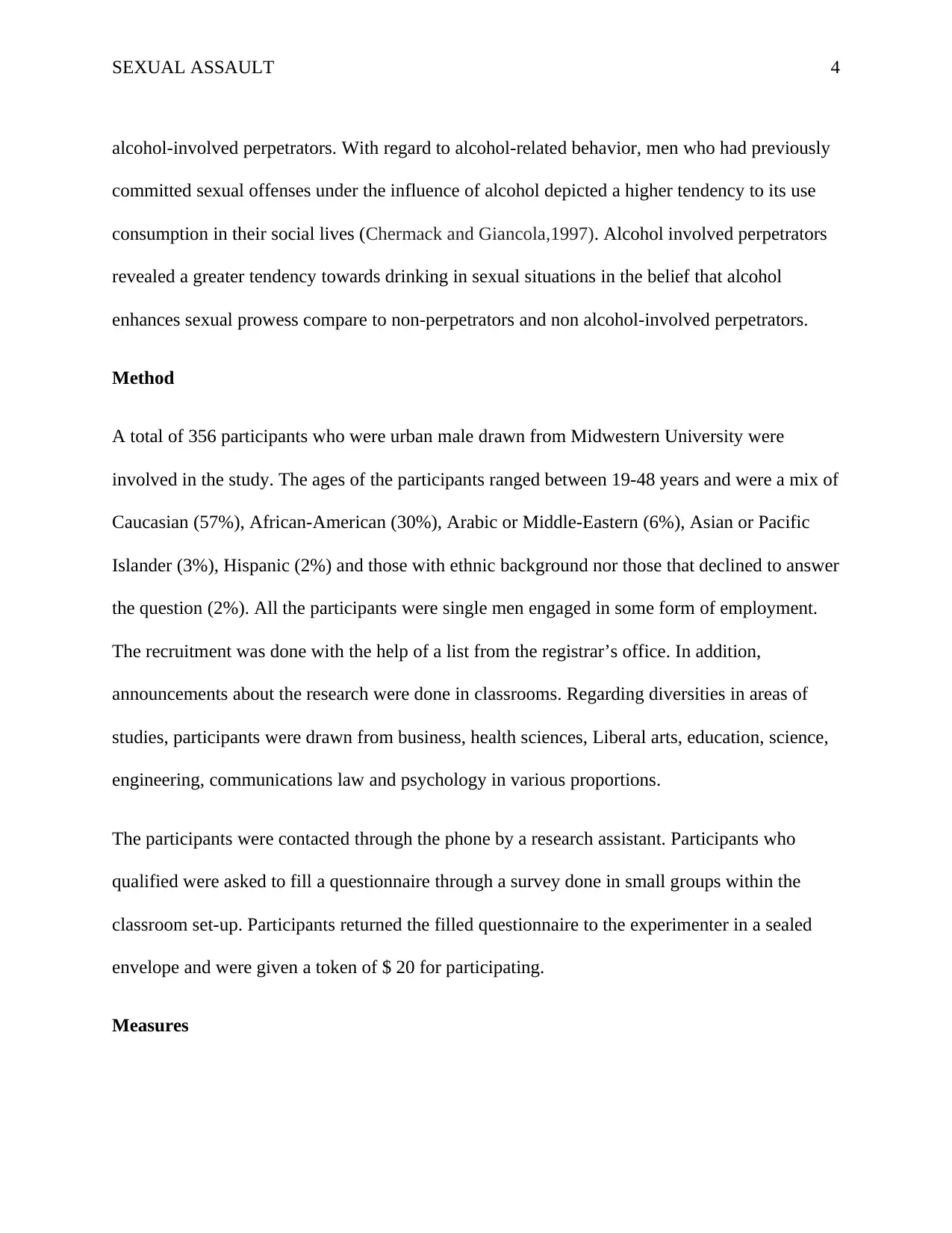
SEXUAL ASSAULT 4
alcohol-involved perpetrators. With regard to alcohol-related behavior, men who had previously
committed sexual offenses under the influence of alcohol depicted a higher tendency to its use
consumption in their social lives (Chermack and Giancola,1997). Alcohol involved perpetrators
revealed a greater tendency towards drinking in sexual situations in the belief that alcohol
enhances sexual prowess compare to non-perpetrators and non alcohol-involved perpetrators.
Method
A total of 356 participants who were urban male drawn from Midwestern University were
involved in the study. The ages of the participants ranged between 19-48 years and were a mix of
Caucasian (57%), African-American (30%), Arabic or Middle-Eastern (6%), Asian or Pacific
Islander (3%), Hispanic (2%) and those with ethnic background nor those that declined to answer
the question (2%). All the participants were single men engaged in some form of employment.
The recruitment was done with the help of a list from the registrar’s office. In addition,
announcements about the research were done in classrooms. Regarding diversities in areas of
studies, participants were drawn from business, health sciences, Liberal arts, education, science,
engineering, communications law and psychology in various proportions.
The participants were contacted through the phone by a research assistant. Participants who
qualified were asked to fill a questionnaire through a survey done in small groups within the
classroom set-up. Participants returned the filled questionnaire to the experimenter in a sealed
envelope and were given a token of $ 20 for participating.
Measures
alcohol-involved perpetrators. With regard to alcohol-related behavior, men who had previously
committed sexual offenses under the influence of alcohol depicted a higher tendency to its use
consumption in their social lives (Chermack and Giancola,1997). Alcohol involved perpetrators
revealed a greater tendency towards drinking in sexual situations in the belief that alcohol
enhances sexual prowess compare to non-perpetrators and non alcohol-involved perpetrators.
Method
A total of 356 participants who were urban male drawn from Midwestern University were
involved in the study. The ages of the participants ranged between 19-48 years and were a mix of
Caucasian (57%), African-American (30%), Arabic or Middle-Eastern (6%), Asian or Pacific
Islander (3%), Hispanic (2%) and those with ethnic background nor those that declined to answer
the question (2%). All the participants were single men engaged in some form of employment.
The recruitment was done with the help of a list from the registrar’s office. In addition,
announcements about the research were done in classrooms. Regarding diversities in areas of
studies, participants were drawn from business, health sciences, Liberal arts, education, science,
engineering, communications law and psychology in various proportions.
The participants were contacted through the phone by a research assistant. Participants who
qualified were asked to fill a questionnaire through a survey done in small groups within the
classroom set-up. Participants returned the filled questionnaire to the experimenter in a sealed
envelope and were given a token of $ 20 for participating.
Measures
Secure Best Marks with AI Grader
Need help grading? Try our AI Grader for instant feedback on your assignments.
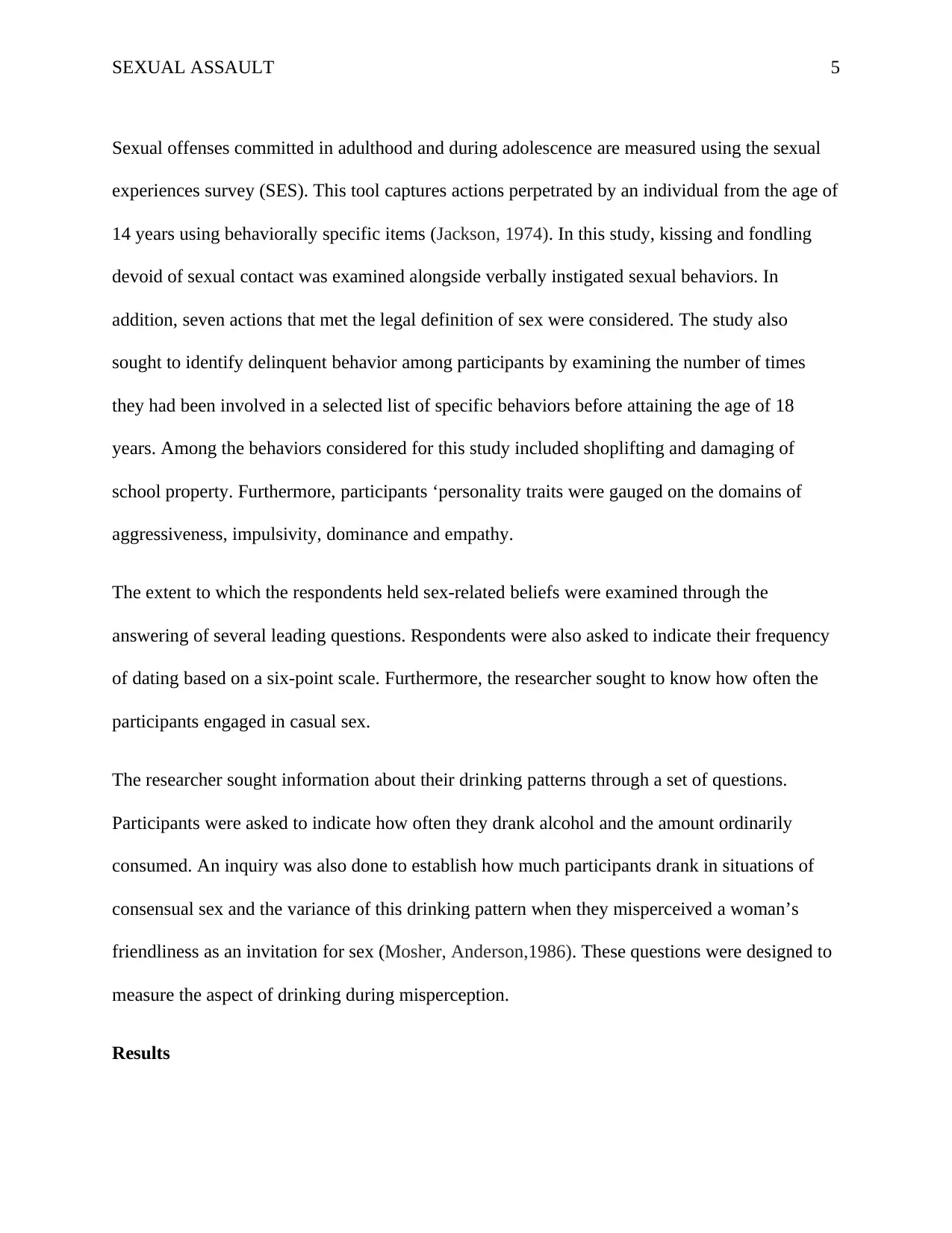
SEXUAL ASSAULT 5
Sexual offenses committed in adulthood and during adolescence are measured using the sexual
experiences survey (SES). This tool captures actions perpetrated by an individual from the age of
14 years using behaviorally specific items (Jackson, 1974). In this study, kissing and fondling
devoid of sexual contact was examined alongside verbally instigated sexual behaviors. In
addition, seven actions that met the legal definition of sex were considered. The study also
sought to identify delinquent behavior among participants by examining the number of times
they had been involved in a selected list of specific behaviors before attaining the age of 18
years. Among the behaviors considered for this study included shoplifting and damaging of
school property. Furthermore, participants ‘personality traits were gauged on the domains of
aggressiveness, impulsivity, dominance and empathy.
The extent to which the respondents held sex-related beliefs were examined through the
answering of several leading questions. Respondents were also asked to indicate their frequency
of dating based on a six-point scale. Furthermore, the researcher sought to know how often the
participants engaged in casual sex.
The researcher sought information about their drinking patterns through a set of questions.
Participants were asked to indicate how often they drank alcohol and the amount ordinarily
consumed. An inquiry was also done to establish how much participants drank in situations of
consensual sex and the variance of this drinking pattern when they misperceived a woman’s
friendliness as an invitation for sex (Mosher, Anderson,1986). These questions were designed to
measure the aspect of drinking during misperception.
Results
Sexual offenses committed in adulthood and during adolescence are measured using the sexual
experiences survey (SES). This tool captures actions perpetrated by an individual from the age of
14 years using behaviorally specific items (Jackson, 1974). In this study, kissing and fondling
devoid of sexual contact was examined alongside verbally instigated sexual behaviors. In
addition, seven actions that met the legal definition of sex were considered. The study also
sought to identify delinquent behavior among participants by examining the number of times
they had been involved in a selected list of specific behaviors before attaining the age of 18
years. Among the behaviors considered for this study included shoplifting and damaging of
school property. Furthermore, participants ‘personality traits were gauged on the domains of
aggressiveness, impulsivity, dominance and empathy.
The extent to which the respondents held sex-related beliefs were examined through the
answering of several leading questions. Respondents were also asked to indicate their frequency
of dating based on a six-point scale. Furthermore, the researcher sought to know how often the
participants engaged in casual sex.
The researcher sought information about their drinking patterns through a set of questions.
Participants were asked to indicate how often they drank alcohol and the amount ordinarily
consumed. An inquiry was also done to establish how much participants drank in situations of
consensual sex and the variance of this drinking pattern when they misperceived a woman’s
friendliness as an invitation for sex (Mosher, Anderson,1986). These questions were designed to
measure the aspect of drinking during misperception.
Results
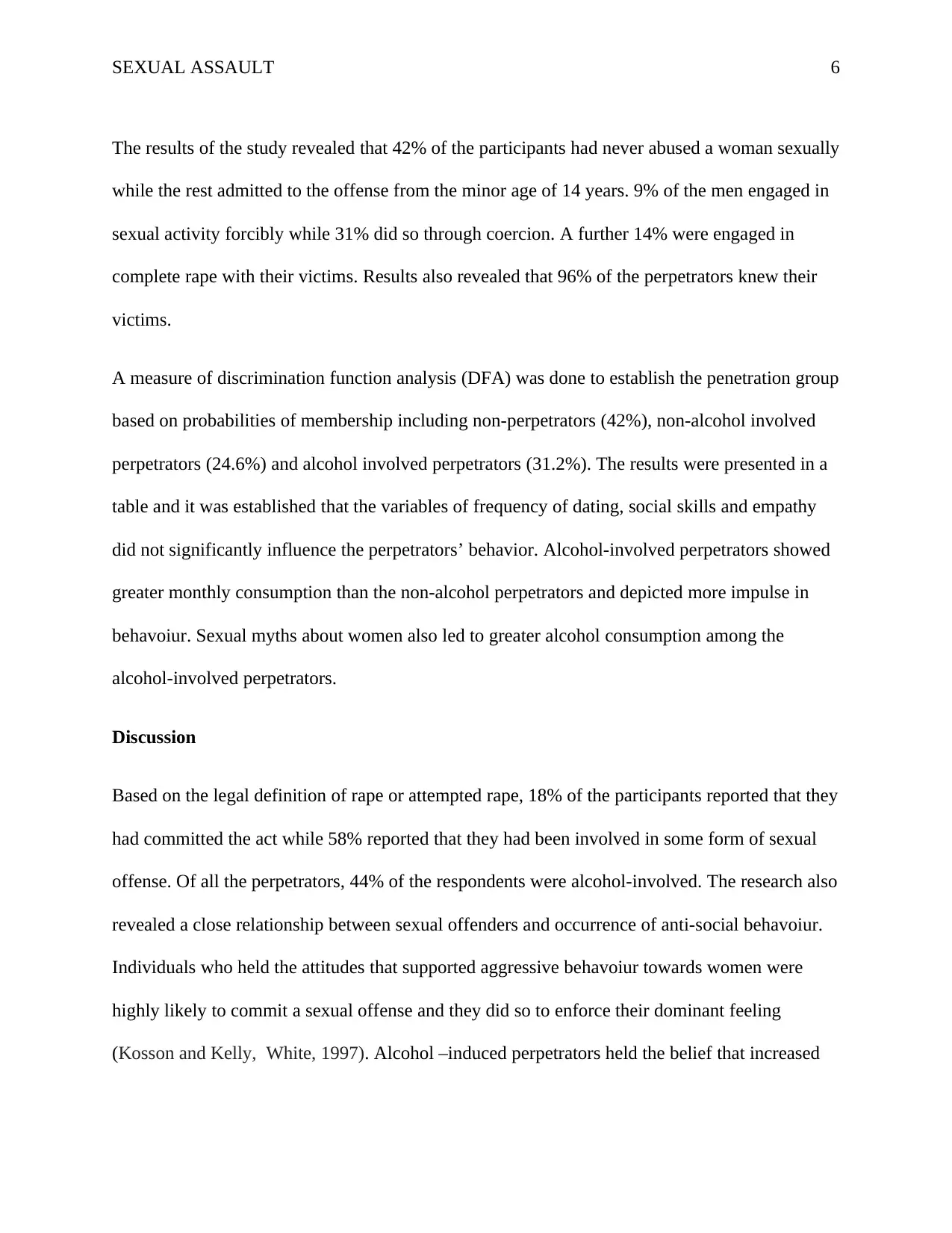
SEXUAL ASSAULT 6
The results of the study revealed that 42% of the participants had never abused a woman sexually
while the rest admitted to the offense from the minor age of 14 years. 9% of the men engaged in
sexual activity forcibly while 31% did so through coercion. A further 14% were engaged in
complete rape with their victims. Results also revealed that 96% of the perpetrators knew their
victims.
A measure of discrimination function analysis (DFA) was done to establish the penetration group
based on probabilities of membership including non-perpetrators (42%), non-alcohol involved
perpetrators (24.6%) and alcohol involved perpetrators (31.2%). The results were presented in a
table and it was established that the variables of frequency of dating, social skills and empathy
did not significantly influence the perpetrators’ behavior. Alcohol-involved perpetrators showed
greater monthly consumption than the non-alcohol perpetrators and depicted more impulse in
behavoiur. Sexual myths about women also led to greater alcohol consumption among the
alcohol-involved perpetrators.
Discussion
Based on the legal definition of rape or attempted rape, 18% of the participants reported that they
had committed the act while 58% reported that they had been involved in some form of sexual
offense. Of all the perpetrators, 44% of the respondents were alcohol-involved. The research also
revealed a close relationship between sexual offenders and occurrence of anti-social behavoiur.
Individuals who held the attitudes that supported aggressive behavoiur towards women were
highly likely to commit a sexual offense and they did so to enforce their dominant feeling
(Kosson and Kelly, White, 1997). Alcohol –induced perpetrators held the belief that increased
The results of the study revealed that 42% of the participants had never abused a woman sexually
while the rest admitted to the offense from the minor age of 14 years. 9% of the men engaged in
sexual activity forcibly while 31% did so through coercion. A further 14% were engaged in
complete rape with their victims. Results also revealed that 96% of the perpetrators knew their
victims.
A measure of discrimination function analysis (DFA) was done to establish the penetration group
based on probabilities of membership including non-perpetrators (42%), non-alcohol involved
perpetrators (24.6%) and alcohol involved perpetrators (31.2%). The results were presented in a
table and it was established that the variables of frequency of dating, social skills and empathy
did not significantly influence the perpetrators’ behavior. Alcohol-involved perpetrators showed
greater monthly consumption than the non-alcohol perpetrators and depicted more impulse in
behavoiur. Sexual myths about women also led to greater alcohol consumption among the
alcohol-involved perpetrators.
Discussion
Based on the legal definition of rape or attempted rape, 18% of the participants reported that they
had committed the act while 58% reported that they had been involved in some form of sexual
offense. Of all the perpetrators, 44% of the respondents were alcohol-involved. The research also
revealed a close relationship between sexual offenders and occurrence of anti-social behavoiur.
Individuals who held the attitudes that supported aggressive behavoiur towards women were
highly likely to commit a sexual offense and they did so to enforce their dominant feeling
(Kosson and Kelly, White, 1997). Alcohol –induced perpetrators held the belief that increased
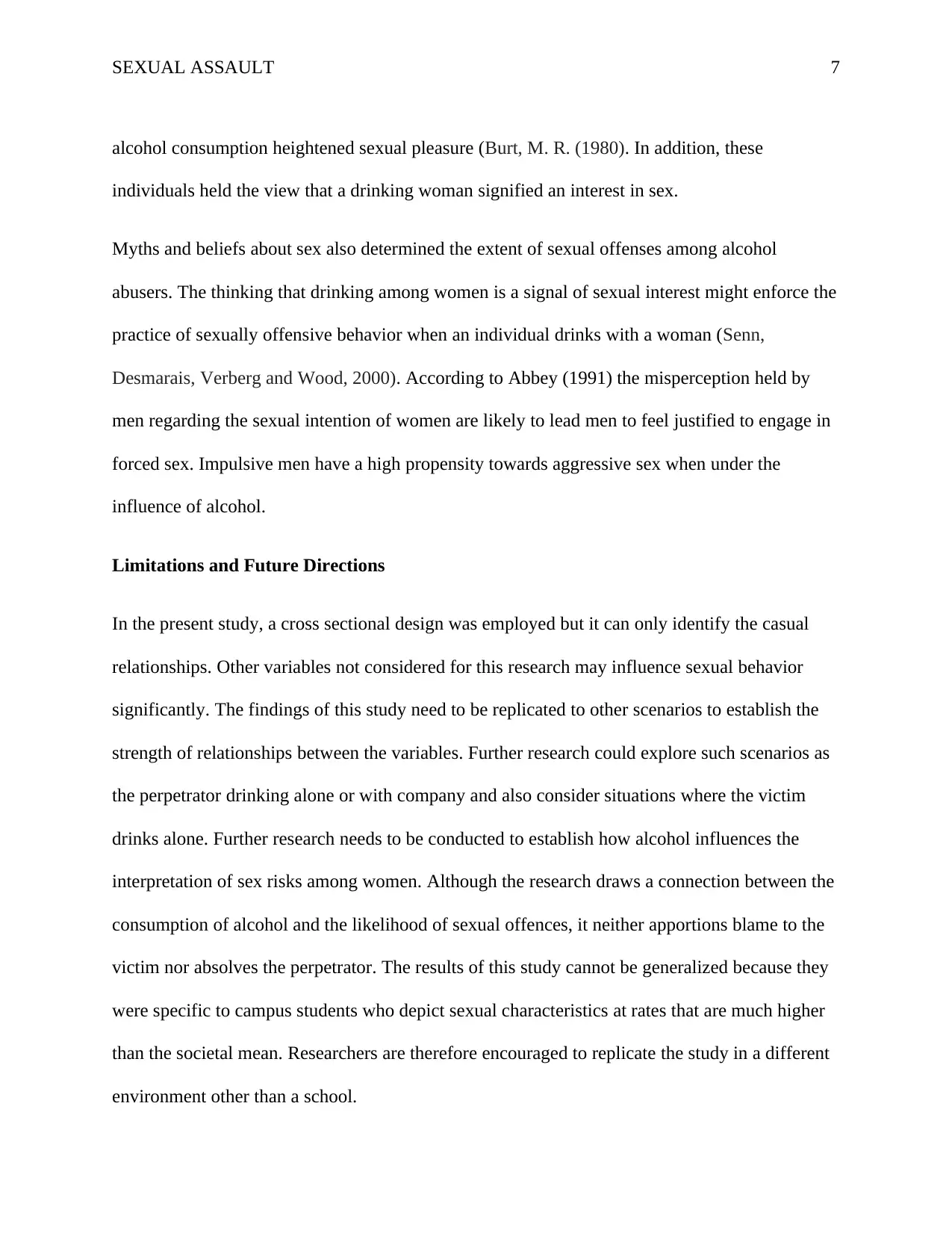
SEXUAL ASSAULT 7
alcohol consumption heightened sexual pleasure (Burt, M. R. (1980). In addition, these
individuals held the view that a drinking woman signified an interest in sex.
Myths and beliefs about sex also determined the extent of sexual offenses among alcohol
abusers. The thinking that drinking among women is a signal of sexual interest might enforce the
practice of sexually offensive behavior when an individual drinks with a woman (Senn,
Desmarais, Verberg and Wood, 2000). According to Abbey (1991) the misperception held by
men regarding the sexual intention of women are likely to lead men to feel justified to engage in
forced sex. Impulsive men have a high propensity towards aggressive sex when under the
influence of alcohol.
Limitations and Future Directions
In the present study, a cross sectional design was employed but it can only identify the casual
relationships. Other variables not considered for this research may influence sexual behavior
significantly. The findings of this study need to be replicated to other scenarios to establish the
strength of relationships between the variables. Further research could explore such scenarios as
the perpetrator drinking alone or with company and also consider situations where the victim
drinks alone. Further research needs to be conducted to establish how alcohol influences the
interpretation of sex risks among women. Although the research draws a connection between the
consumption of alcohol and the likelihood of sexual offences, it neither apportions blame to the
victim nor absolves the perpetrator. The results of this study cannot be generalized because they
were specific to campus students who depict sexual characteristics at rates that are much higher
than the societal mean. Researchers are therefore encouraged to replicate the study in a different
environment other than a school.
alcohol consumption heightened sexual pleasure (Burt, M. R. (1980). In addition, these
individuals held the view that a drinking woman signified an interest in sex.
Myths and beliefs about sex also determined the extent of sexual offenses among alcohol
abusers. The thinking that drinking among women is a signal of sexual interest might enforce the
practice of sexually offensive behavior when an individual drinks with a woman (Senn,
Desmarais, Verberg and Wood, 2000). According to Abbey (1991) the misperception held by
men regarding the sexual intention of women are likely to lead men to feel justified to engage in
forced sex. Impulsive men have a high propensity towards aggressive sex when under the
influence of alcohol.
Limitations and Future Directions
In the present study, a cross sectional design was employed but it can only identify the casual
relationships. Other variables not considered for this research may influence sexual behavior
significantly. The findings of this study need to be replicated to other scenarios to establish the
strength of relationships between the variables. Further research could explore such scenarios as
the perpetrator drinking alone or with company and also consider situations where the victim
drinks alone. Further research needs to be conducted to establish how alcohol influences the
interpretation of sex risks among women. Although the research draws a connection between the
consumption of alcohol and the likelihood of sexual offences, it neither apportions blame to the
victim nor absolves the perpetrator. The results of this study cannot be generalized because they
were specific to campus students who depict sexual characteristics at rates that are much higher
than the societal mean. Researchers are therefore encouraged to replicate the study in a different
environment other than a school.
Paraphrase This Document
Need a fresh take? Get an instant paraphrase of this document with our AI Paraphraser
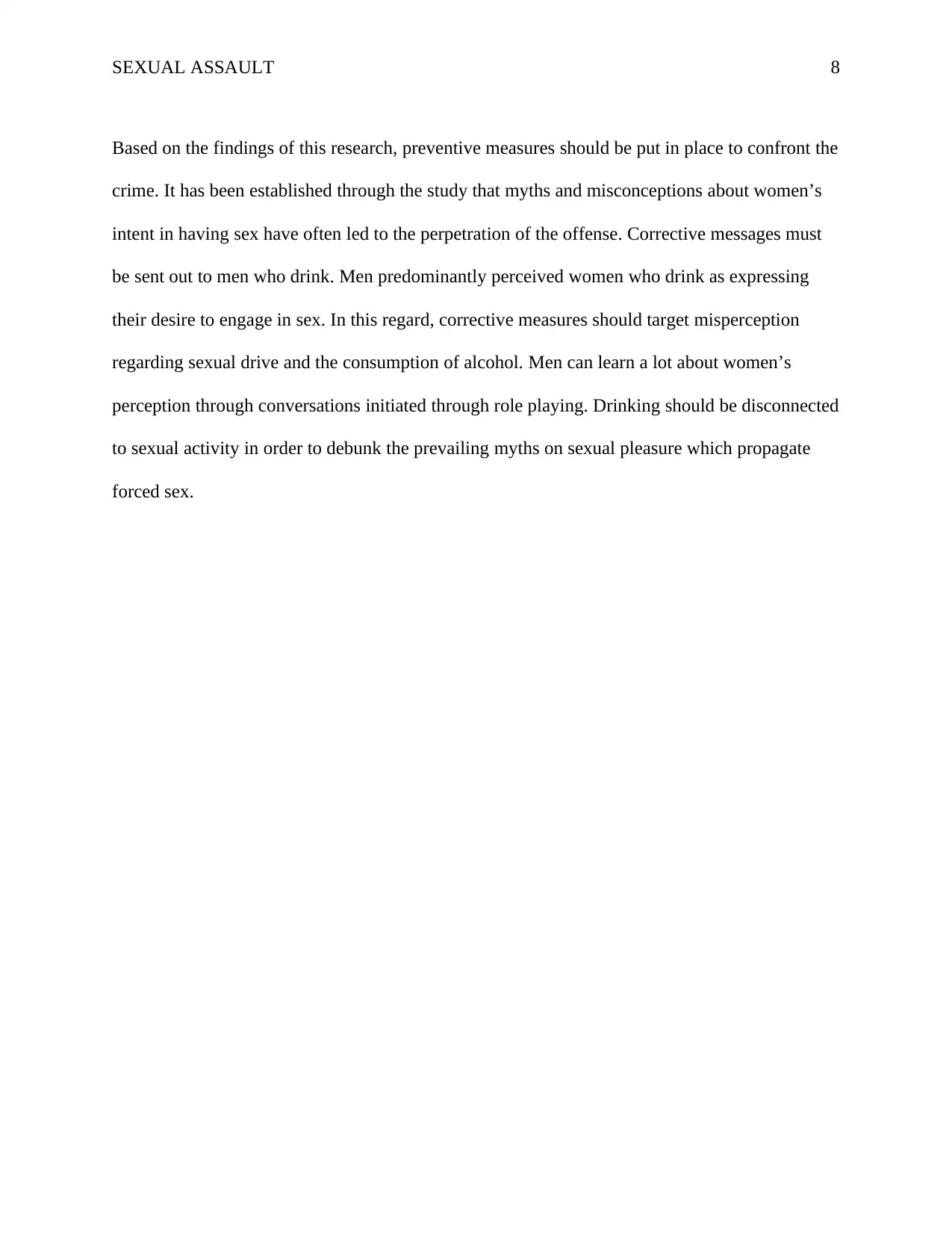
SEXUAL ASSAULT 8
Based on the findings of this research, preventive measures should be put in place to confront the
crime. It has been established through the study that myths and misconceptions about women’s
intent in having sex have often led to the perpetration of the offense. Corrective messages must
be sent out to men who drink. Men predominantly perceived women who drink as expressing
their desire to engage in sex. In this regard, corrective measures should target misperception
regarding sexual drive and the consumption of alcohol. Men can learn a lot about women’s
perception through conversations initiated through role playing. Drinking should be disconnected
to sexual activity in order to debunk the prevailing myths on sexual pleasure which propagate
forced sex.
Based on the findings of this research, preventive measures should be put in place to confront the
crime. It has been established through the study that myths and misconceptions about women’s
intent in having sex have often led to the perpetration of the offense. Corrective messages must
be sent out to men who drink. Men predominantly perceived women who drink as expressing
their desire to engage in sex. In this regard, corrective measures should target misperception
regarding sexual drive and the consumption of alcohol. Men can learn a lot about women’s
perception through conversations initiated through role playing. Drinking should be disconnected
to sexual activity in order to debunk the prevailing myths on sexual pleasure which propagate
forced sex.
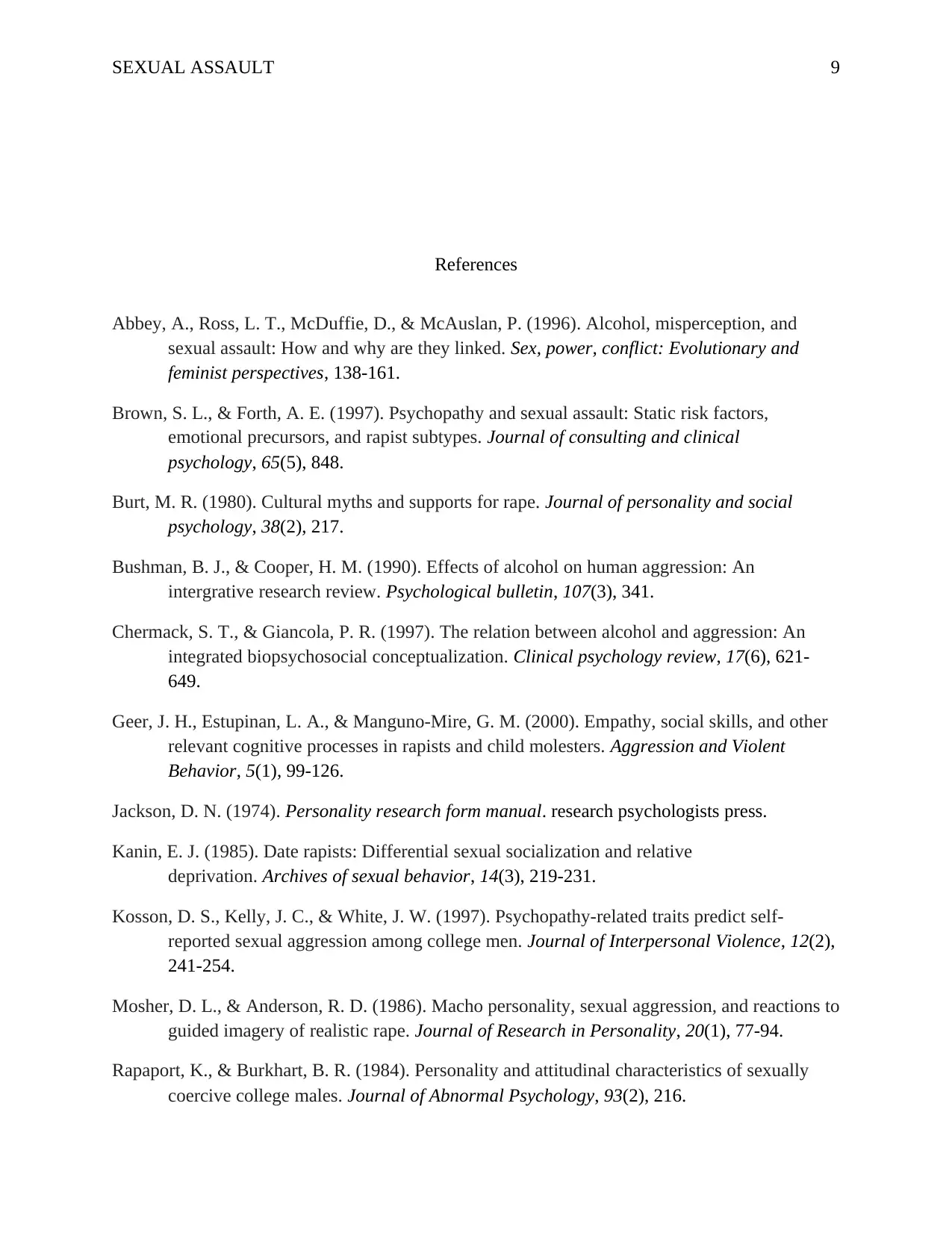
SEXUAL ASSAULT 9
References
Abbey, A., Ross, L. T., McDuffie, D., & McAuslan, P. (1996). Alcohol, misperception, and
sexual assault: How and why are they linked. Sex, power, conflict: Evolutionary and
feminist perspectives, 138-161.
Brown, S. L., & Forth, A. E. (1997). Psychopathy and sexual assault: Static risk factors,
emotional precursors, and rapist subtypes. Journal of consulting and clinical
psychology, 65(5), 848.
Burt, M. R. (1980). Cultural myths and supports for rape. Journal of personality and social
psychology, 38(2), 217.
Bushman, B. J., & Cooper, H. M. (1990). Effects of alcohol on human aggression: An
intergrative research review. Psychological bulletin, 107(3), 341.
Chermack, S. T., & Giancola, P. R. (1997). The relation between alcohol and aggression: An
integrated biopsychosocial conceptualization. Clinical psychology review, 17(6), 621-
649.
Geer, J. H., Estupinan, L. A., & Manguno-Mire, G. M. (2000). Empathy, social skills, and other
relevant cognitive processes in rapists and child molesters. Aggression and Violent
Behavior, 5(1), 99-126.
Jackson, D. N. (1974). Personality research form manual. research psychologists press.
Kanin, E. J. (1985). Date rapists: Differential sexual socialization and relative
deprivation. Archives of sexual behavior, 14(3), 219-231.
Kosson, D. S., Kelly, J. C., & White, J. W. (1997). Psychopathy-related traits predict self-
reported sexual aggression among college men. Journal of Interpersonal Violence, 12(2),
241-254.
Mosher, D. L., & Anderson, R. D. (1986). Macho personality, sexual aggression, and reactions to
guided imagery of realistic rape. Journal of Research in Personality, 20(1), 77-94.
Rapaport, K., & Burkhart, B. R. (1984). Personality and attitudinal characteristics of sexually
coercive college males. Journal of Abnormal Psychology, 93(2), 216.
References
Abbey, A., Ross, L. T., McDuffie, D., & McAuslan, P. (1996). Alcohol, misperception, and
sexual assault: How and why are they linked. Sex, power, conflict: Evolutionary and
feminist perspectives, 138-161.
Brown, S. L., & Forth, A. E. (1997). Psychopathy and sexual assault: Static risk factors,
emotional precursors, and rapist subtypes. Journal of consulting and clinical
psychology, 65(5), 848.
Burt, M. R. (1980). Cultural myths and supports for rape. Journal of personality and social
psychology, 38(2), 217.
Bushman, B. J., & Cooper, H. M. (1990). Effects of alcohol on human aggression: An
intergrative research review. Psychological bulletin, 107(3), 341.
Chermack, S. T., & Giancola, P. R. (1997). The relation between alcohol and aggression: An
integrated biopsychosocial conceptualization. Clinical psychology review, 17(6), 621-
649.
Geer, J. H., Estupinan, L. A., & Manguno-Mire, G. M. (2000). Empathy, social skills, and other
relevant cognitive processes in rapists and child molesters. Aggression and Violent
Behavior, 5(1), 99-126.
Jackson, D. N. (1974). Personality research form manual. research psychologists press.
Kanin, E. J. (1985). Date rapists: Differential sexual socialization and relative
deprivation. Archives of sexual behavior, 14(3), 219-231.
Kosson, D. S., Kelly, J. C., & White, J. W. (1997). Psychopathy-related traits predict self-
reported sexual aggression among college men. Journal of Interpersonal Violence, 12(2),
241-254.
Mosher, D. L., & Anderson, R. D. (1986). Macho personality, sexual aggression, and reactions to
guided imagery of realistic rape. Journal of Research in Personality, 20(1), 77-94.
Rapaport, K., & Burkhart, B. R. (1984). Personality and attitudinal characteristics of sexually
coercive college males. Journal of Abnormal Psychology, 93(2), 216.
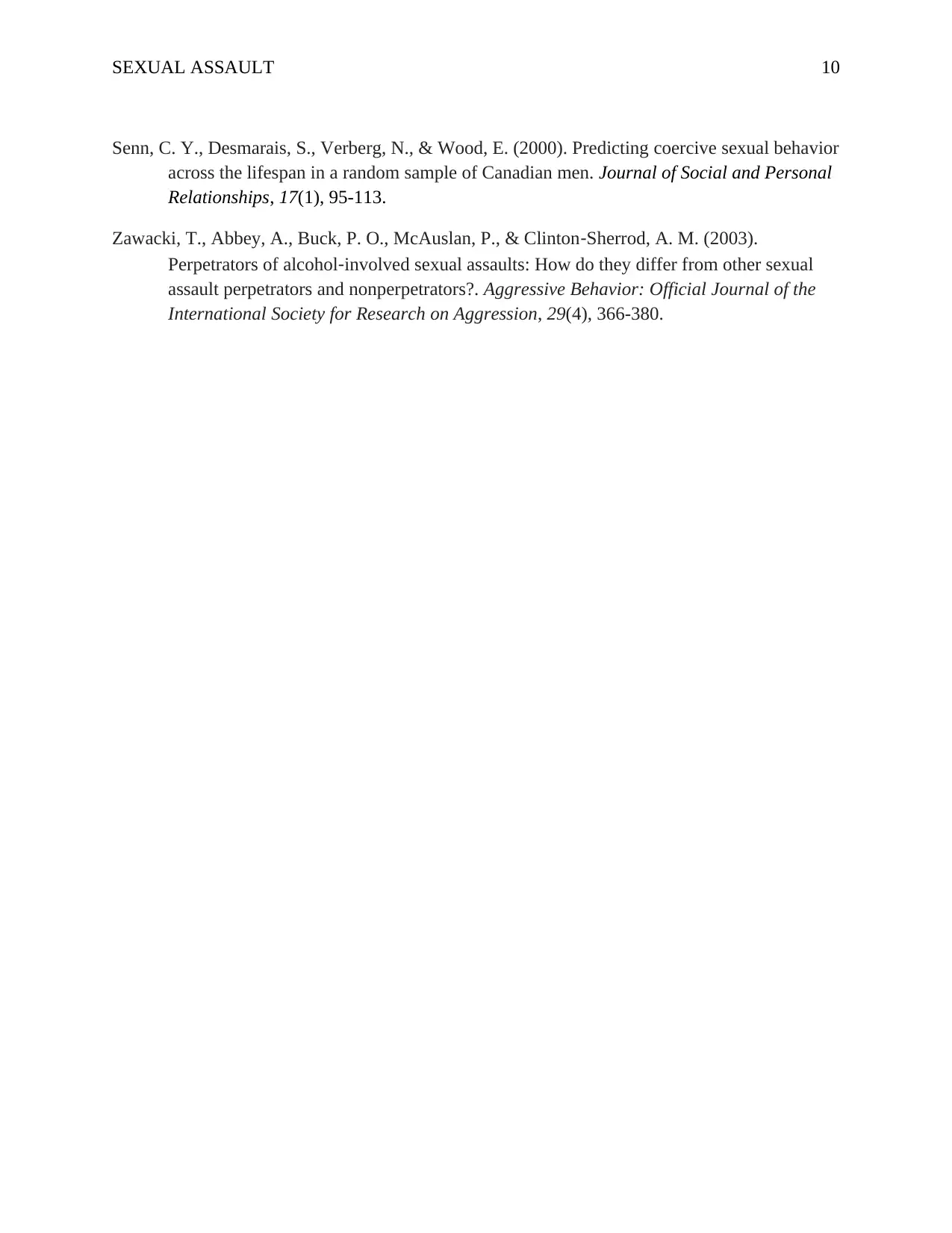
SEXUAL ASSAULT 10
Senn, C. Y., Desmarais, S., Verberg, N., & Wood, E. (2000). Predicting coercive sexual behavior
across the lifespan in a random sample of Canadian men. Journal of Social and Personal
Relationships, 17(1), 95-113.
Zawacki, T., Abbey, A., Buck, P. O., McAuslan, P., & Clinton‐Sherrod, A. M. (2003).
Perpetrators of alcohol‐involved sexual assaults: How do they differ from other sexual
assault perpetrators and nonperpetrators?. Aggressive Behavior: Official Journal of the
International Society for Research on Aggression, 29(4), 366-380.
Senn, C. Y., Desmarais, S., Verberg, N., & Wood, E. (2000). Predicting coercive sexual behavior
across the lifespan in a random sample of Canadian men. Journal of Social and Personal
Relationships, 17(1), 95-113.
Zawacki, T., Abbey, A., Buck, P. O., McAuslan, P., & Clinton‐Sherrod, A. M. (2003).
Perpetrators of alcohol‐involved sexual assaults: How do they differ from other sexual
assault perpetrators and nonperpetrators?. Aggressive Behavior: Official Journal of the
International Society for Research on Aggression, 29(4), 366-380.
1 out of 10
Related Documents
Your All-in-One AI-Powered Toolkit for Academic Success.
+13062052269
info@desklib.com
Available 24*7 on WhatsApp / Email
![[object Object]](/_next/static/media/star-bottom.7253800d.svg)
Unlock your academic potential
© 2024 | Zucol Services PVT LTD | All rights reserved.





